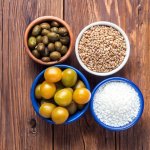I am thinking to prepare a Greek-style pork dish for my Christmas meal. How do people usually do it? Is it a roast? I was thinking of marinating the roast meat in a ladolemono overnight and roasting it with potatoes...
What types of sides do people serve with this, besides the potatoes?
What types of sides do people serve with this, besides the potatoes?



